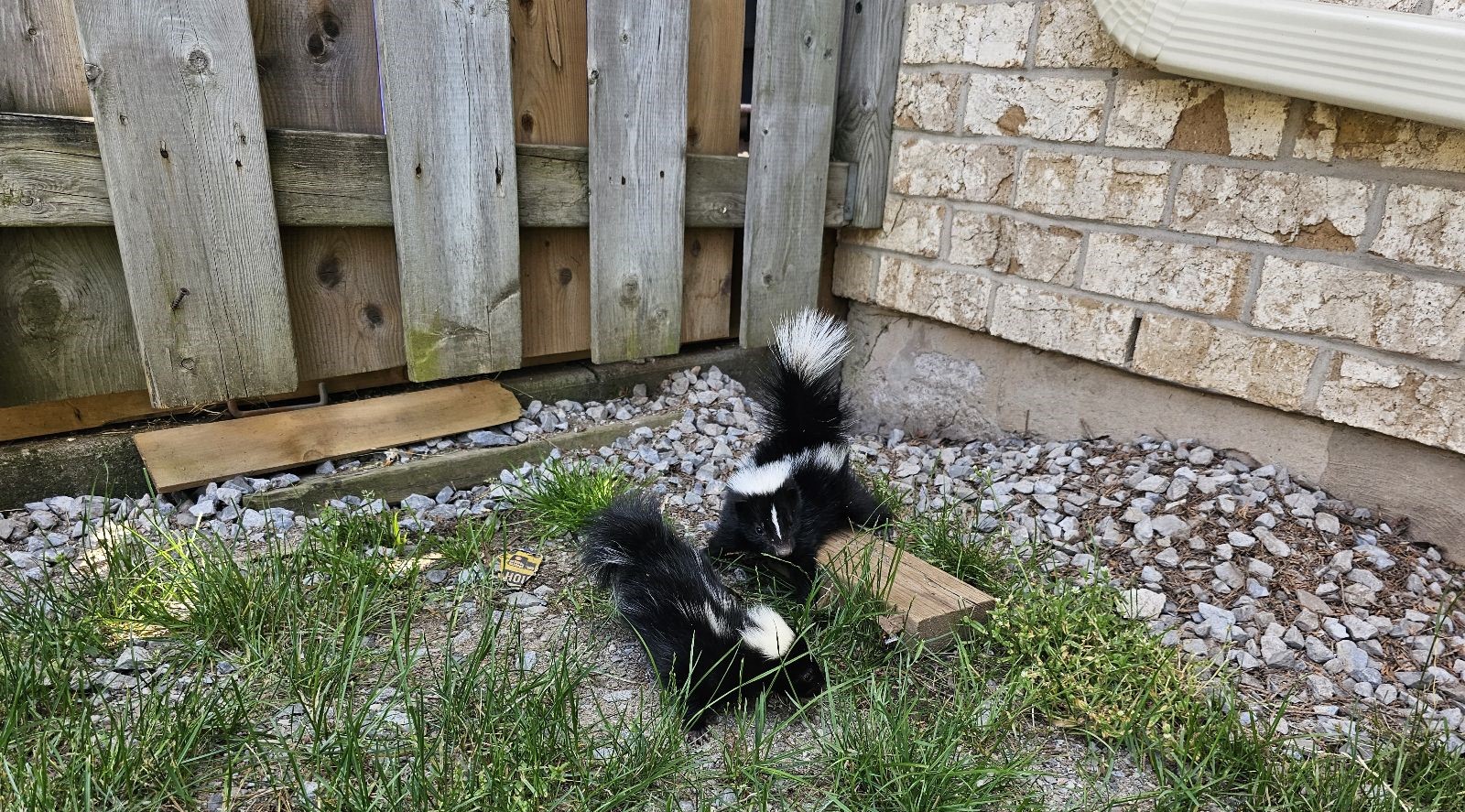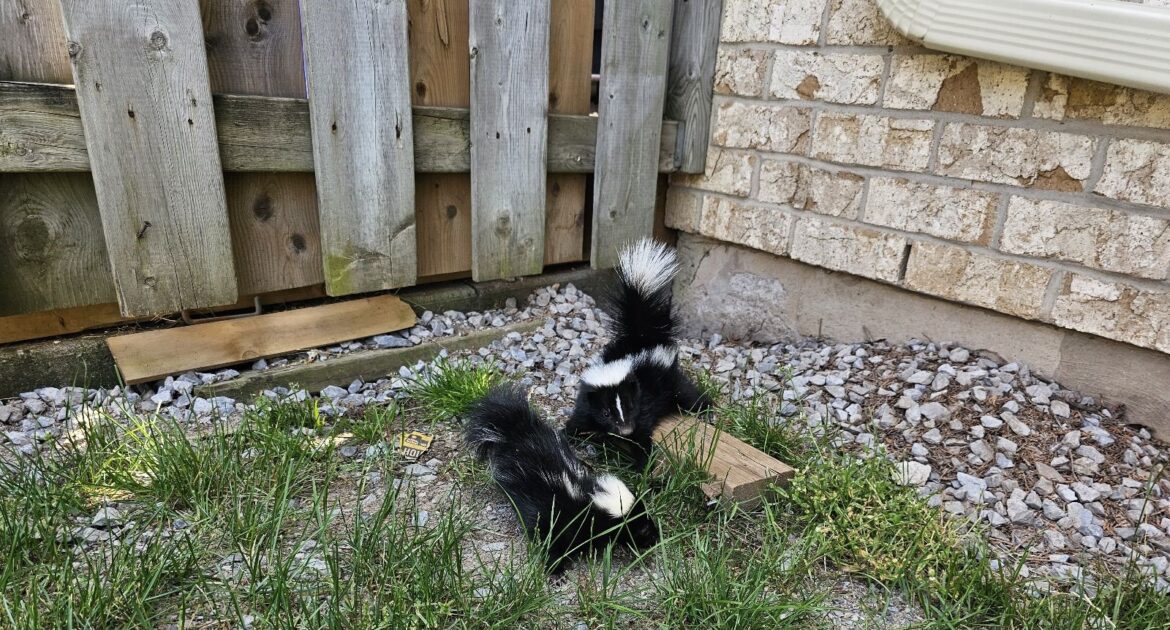On a crisp fall evening, as you relax in the quiet of your backyard, you may have unexpected company. With temperatures dropping, skunks begin seeking warm, sheltered spots to nest. While they don’t hibernate completely, they enter a slower, more dormant state during winter, relying on these hidden retreats to stay safe and insulated from the cold.
Skunks are very good at finding spots in your yard to make their home. They might go under your deck or porch, hide in thick bushes or wood piles, or even settle near your shed or garage. Knowing where skunks like to nest is important because their presence can cause bad smells and damage to your property.
That’s why it’s helpful to recognize skunk habits in these nesting areas early. Skedaddle Humane Wildlife Control in Baltimore can help keep your yard safe from skunks using humane and effective solutions. Let’s take a closer look at the most common places skunks might nest and how to keep them from moving in.
Under Decks and Porches
Decks and porches offer the perfect refuge for certain wildlife during the colder months. These structures provide excellent protection from rain, wind, and freezing temperatures. For animals looking for a cozy spot, this shelter is highly attractive. They create a warm and safe environment that protects from harsh weather, making them perfect for animals that prefer a consistent climate during winter.
One of the main reasons why these areas are so often chosen is the easy access they offer. Open spaces or gaps around the perimeter of decks make an ideal entry point. It’s like a welcoming invitation for those seeking a snug spot to settle. Unfortunately, for homeowners, this might mean unexpected visitors taking up residence without your consent.
Beneath Sheds and Outbuildings
In the quietest corners of your yard, such as beneath sheds and outbuildings, skunks often find ideal nesting spots. These quiet and peaceful spots are perfect for skunks looking for shelter when the weather gets cold. Sheds and similar structures give them protection from the cold and are usually not visited by people very often. It’s no wonder skunks use their instincts to pick these safe places to stay warm during the winter.
A small crack or gap in the foundations of sheds can become a welcome mat for skunks looking for a cozy home. These tiny openings might seem insignificant, but for a skunk, they provide access to the hidden spaces underneath. Once they slip inside, the skunks can safely tuck away from the world, enjoying the quiet sanctuary below. For homeowners, it’s important to check these areas regularly, ensuring that any potential access points are sealed.
Near Rock or Wood Piles
Natural cover in your yard, such as rock or wood piles, provides convenient hiding spots for animals seeking protection during winter. These piles offer superb concealment from predators, serving as a thick and sturdy barrier. The spaces between rocks or logs form natural little caves that are an animal’s safe haven when temperatures drop or danger approaches.
These areas can become more than just temporary shelters. While initially appealing for quick refuge, piles of rocks or wood can easily transform into long-term nesting spots due to their quiet and concealed nature. With such secure and readily available habitats, small animals may find it hard to resist settling down for months. By staying aware and managing these natural structures, homeowners can prevent unwanted guests from making these piles a permanent home.
In Dense Shrubs and Bushes
Thick bushes and overgrown vegetation can become a hidden sanctuary for skunks during the colder months. These lush, leafy areas offer great cover and protection from the elements. Skunks, with their shy nature, find such spots very appealing as they search for a quiet place away from potential threats. The dense foliage acts as a natural shield, making it an ideal spot to settle when the temperature begins to drop.
These cozy nooks are often conveniently located near abundant food sources like insects or berries. This proximity makes them even more attractive for animals seeking both shelter and sustenance. Imagine having a safe and warm area with an array of tasty treats right nearby—it’s like the perfect winter home! Regular checks of these areas and light maintenance can help keep your yard from becoming a permanent retreat for local wildlife.
Burrows in the Ground
If you see holes appearing in your yard, it’s possible that existing burrows have been taken over by a skunk. They often repurpose abandoned burrows left behind by other animals like groundhogs. It’s a convenient way for them to establish a home without expending much energy.
However, if no suitable options are available, they are also capable of digging their own dens in soft soil. Keep an eye out for freshly dug earth, especially in areas that may provide adequate cover or access to resources.
Compost Piles or Trash Storage Areas
Improperly sealed trash bins or compost piles can become a buffet for local wildlife. The presence of organic matter or food waste is highly attractive and can lure them into your yard. Once they find an easily accessible food source, they might decide to nest nearby for convenience.
These areas can serve dual purposes, functioning both as a feeding station and a nesting site. Ensuring your bins are sealed, and your compost is managed correctly can help reduce these attractions.
Near Fences or Walls
The edges of your property, along fences or walls, can become popular nesting sites. These boundaries offer shelter and security, making them appealing to wildlife. The proximity to the edge of the property provides a sense of safety from human activity.
Animals like to burrow under fences where the soil is often loose and easy to dig through. Regular inspections along your property’s boundaries can help you spot any signs of movement or nesting.
Stay Skunk-Free This Winter
Being aware of the preferred habitats for skunks in your yard can prevent unwanted surprises. Skunks often make their homes under decks, porches, sheds, and outbuildings. They also like hiding near piles of rocks or wood, in thick bushes, or in holes in the ground. Compost piles and trash areas can attract skunks because they provide easy food. Skunks also feel safe nesting along fences or walls at the edges of properties.
By keeping a vigilant eye on these common nesting sites for signs of skunk activity, you can take the necessary steps to deter them. If you notice any signs of skunks, it’s important to take action to avoid conflicts with skunks.
Understanding “what do skunks do in the winter” and “what temperature do skunks hibernate” are key to staying skunk-free. By familiarizing yourself with skunk habits and their nesting preferences, you can prepare effectively for their winter activities.
If you need assistance, don’t hesitate to “contact us” for a quote or to learn more about safe, humane wildlife control options. Reach out to Skedaddle Humane Wildlife Control today and ensure your yard remains a peaceful space for both you and the wildlife that surrounds it.




